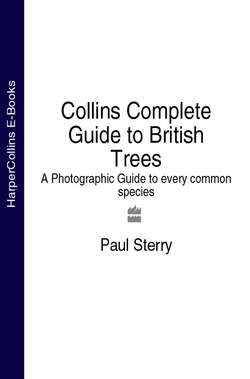Читать книгу Collins Complete Guide to British Trees: A Photographic Guide to every common species - Paul Sterry - Страница 18
ОглавлениеIDENTIFYING TREES
Very little equipment is required to identify trees, but a few simple items are helpful. The first essential is a notebook in which to record observations in the field. The traditional botanists’ rule ‘Take the book to the plant and not the plant to the book’ applies to trees in that snapping off twigs, fruits or flowers should be avoided where possible; this may be prohibited, or may simply be bad manners if the tree in question is growing in a garden or park, for example. Some arboreta and botanical gardens are very firm in prohibiting the removal of living materials and may take action against a person who damages a tree. It is best if detailed notes can be made in the field, and if there are some fallen leaves or fruits beneath the tree, and it is certain that they are from the tree in question and not any other nearby trees, then these can be taken for help in identification.
Photographs are a very useful way of keeping records and will be of great help in identification. A record of the same tree in different seasons of the year would be helpful to show the changes in foliage colour and the appearance of the flowers.
A hand-lens, capable of magnifying up to × 10, is very helpful. Many features of trees, even very large specimens, are easier to see in close-up. Coniferous trees often have lines of tiny pores (stomata) on their needles, and the number and arrangement of these can be crucial to correct identification. The degree of hairiness of the leaves and petioles is often very important; some species have hairs in the form of tiny stars, while others may have fine hairs of a particular colour, both features that can only be reliably seen in close-up. The arrangement of the parts of the flowers often helps in tracing a tree to a particular family and these parts are usually quite small.
A small ruler with a scale marked in millimetres is also very useful as the measurements of needles, leaves, petioles and floral parts can be very important, although it should be stressed that these are often variable. A longer tape-measure is also helpful for measuring the circumference of trees; this information can be used to estimate the age of most trees (see p.).
ESTIMATING THE HEIGHT OF A TREE
Although the height of a tree is not a definitive guide to identification – trees grow after all – it often helps to know this measurement when deciding on a species’ identity. There are a number of simple methods that can be used with reasonable accuracy but the following is the most straightforward.
Hold a straight stick vertically in front of you, at arm’s length, and line it up with the tree. Move backwards or forwards until the stick appears to be the same height as the tree and then rotate the stick through 90 degrees until it is horizontal. Keeping one end of the stick in line with the base of the trunk, ask a friend to stand in line with the other end of the stick, along the trajectory if the tree fell over and lay at right angles to your orientation. Measure the distance between your friend and the base of the tree trunk and this will tell you the height of the tree.
Measuring tree height.
